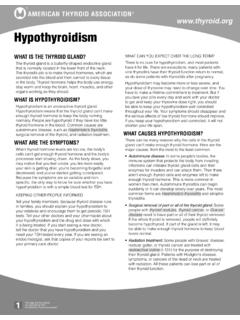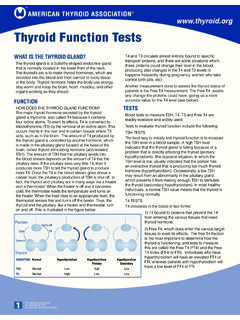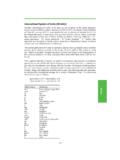Transcription of Thyroid Testing In Dogs: A Reference for Dog Breeders & …
1 Thyroid Testing In Dogs A Reference for Dog Breeders & Owners Karen J. Wolfsheimer, DVM, Diplomat, American College of Veterinary Internal Medicine Associate Professor Department of Physiology, Pharmacology & Toxicology and Colleen Brady, Veterinary Student School of Veterinary Medicine Louisiana State University Baton Rouge, LA 70803. Hypothyroidism is a relatively common endocrine disease of dogs which results from progressive loss of functioning Thyroid tissue. While epidemiological studies are few and somewhat conflicting, it appears that hypothyroidism occurs more frequently in certain breeds and lines, especially in large breed dogs.
2 It is usually caused by lymphocytic thyroiditis (most likely an immune-mediated disease) or idiopathic Thyroid atrophy (shrinking of Thyroid tissue from unknown causes). The disease can occur in either sex and usually becomes apparent in young adults (1-3 years of age). or middle-aged dogs (4-9 years of age). Clinical signs may include hair loss, seborrhea, bacterial skin infections, excessive skin pigmentation, lethargy, obesity, muscle or nerve weakness, slow heart rate and reproductive disorders. Abnormal blood tests may reveal mild anemia and an increase in lipids, especially cholesterol. Making a definitive diagnosis of hypothyroidism can be difficult because signs of hypothyroidism can be confused with other diseases.
3 In addition, interpretation of diagnostic tests for hypothyroidism can be confusing and not specific for Thyroid dysfunction. Also, there is variation within normal Thyroid hormone concentrations which must be considered when evaluating any test results. Younger dogs will have higher Thyroid hormone concentrations than older dogs. Certain breeds, such as the greyhound, normally have lower Thyroid hormone concentrations. At this time, there is no ideal test, which is readily available and affordable, that is specific for diagnosing hypothyroidism. The most commonly used Thyroid tests are those that evaluate Thyroid gland function by measuring Thyroid hormone concentrations in the blood.
4 The Total T4, Total T3, Free T4 and TSH concentration tests measure various hormone concentrations at rest. The TSH and TRH stimulation tests measure hormone concentrations after stimulation of the Thyroid gland. Other available tests evaluate Thyroid gland pathology and include the measurement of antibodies to Thyroid hormones (T3 or T4) or thyroglobulin, as well as Thyroid biopsy. A much less common diagnostic procedure is the Radioactive Iodine Uptake (RAIU) study. RAIU studies do not accurately reflect Thyroid gland function but simply determine the turnover of iodine in the Thyroid gland. Results can be affected by the amount of iodide in the diet and non- Thyroid illness.
5 Because of these factors, as well as the expense, radiation exposure and the necessity for sedation, RAIU studies and radioisotope scans are not routinely used to diagnose hypothyroidism in dogs. hormone concentrations are usually measured by radioimmunoassay (RIA), although chemiluminescence, fluorescence polarization (TDX) and enzyme-linked immunosorbent (ELISA) assays are also being used. Regardless of the assay, it is important that the laboratory uses an assay that has been validated for use in dogs and that each laboratory establishes its own normal canine Reference ranges. While most veterinary laboratories have done this, it is 1.
6 Less common in human Reference laboratories. It is essential to verify this when ordering tests from a human laboratory. TOTAL T3 CONCENTRATION. Total T3 concentration (TT3) is the amount of total (free plus protein-bound) tri-iodothyronine (liothyronine). measured in the blood. It is the most active form of Thyroid hormone at the cellular level. However, it is not the major hormone made by the Thyroid gland and is formed by conversion from T4 (or thyroxine) in the peripheral tissues of the body. Hypothyroid dogs will often have normal concentrations of TT3 in the blood. Some veterinarians propose that there can be a defect in the conversion of T4 to T3, thus causing hypothyroidism.
7 This defect is rare in people and not well documented in dogs. Occasionally, hypothyroid dogs form antibodies to circulating T3 in the blood, due to immune-mediated disease. These dogs can show elevated concentrations of TT3 in the blood. Because of these facts, measurement of TT3 in the blood is not an accurate reflection of Thyroid gland function. TOTAL T4 CONCENTRATION. Total T4 concentration (TT4) is the amount of total (free plus protein-bound) thyroxine measured in the blood. It is the predominant hormone made by the Thyroid gland. While it has some biological activity itself, its major purpose is to be converted to T3, the more active Thyroid hormone , in the peripheral tissues of the body.
8 The free portion of T4 is the active available form of the hormone , while the protein-bound portion serves as a reservoir for hormone in the circulating blood. The protein-bound portion of TT4 can be lowered by non- Thyroid illnesses, other hormones (cortisol) and certain drugs. Drugs that can lower protein-bound T4 (and therefore TT4) include steroids (cortisone, prednisolone, prednisone, etc.), non-steroidal anti-inflammatory drugs (phenylbutazone and others), anticonvulsant or seizure drugs (Phenobarbital), certain potentiated sulfa drug antibiotics and potentially other drugs. Therefore, a dog with normal Thyroid gland function could have a low TT4 due to lowering the protein-bound portion of TT4.
9 It is very important that the veterinarian evaluating a dog for Thyroid function know about all medications and any other medical conditions that the dog might be suffering from. Results of the measurement of TT4 can be misleading if one of the above mentioned conditions exist. FREE T4 CONCENTRATION. Free T4 concentration is the amount of free or active thyroxine not bound to protein in the blood. As previously explained, protein-bound T4 can be lowered by non- Thyroid illness and drugs. The free T4 portion is less likely to be affected by non- Thyroid illness and drugs; therefore, it more accurately reflects true Thyroid gland function.
10 However, steroids (or a condition of excess internal cortisol called Cushing's Syndrome) can lower free T4 concentrations in some cases. When measuring free T4 concentrations, it is important that the laboratory utilize a technique called equilibrium dialysis in performing the free T4 assay. Other "analog" techniques are not as useful in obtaining accurate results. Due to this equilibrium dialysis step which properly separates the free T4, this test is more expensive than other hormone assays. A formula incorporating the concentration of free T4 measured by equilibrium dialysis and cholesterol may be utilized to improve the diagnostic accuracy of a single blood sample.







